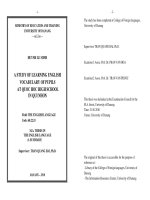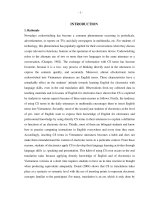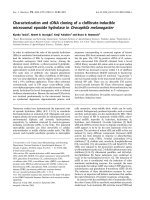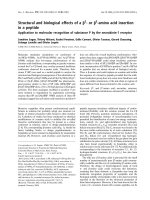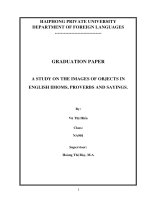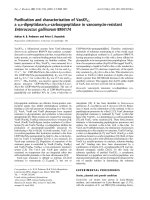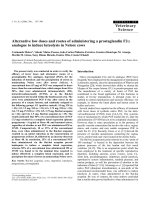Subtitled authentic videos and incidental vocabulary learning a study among efl high school students in thanh hoa
Bạn đang xem bản rút gọn của tài liệu. Xem và tải ngay bản đầy đủ của tài liệu tại đây (1.12 MB, 86 trang )
MINISTRY OF EDUCATION AND TRAINING
VINH UNIVERSITY
NGUYEN THI THANH HUYEN
SUBTITLED AUTHENTIC VIDEOS AND INCIDENTAL
VOCABULARY LEARNING: A STUDY AMONG EFL HIGH
SCHOOL STUDENTS IN THANH HOA
MASTER’S THESIS IN EDUCATION
NGHỆ AN- 2017
1
MINISTRY OF EDUCATION AND TRAINING
VINH UNIVERSITY
NGUYEN THI THANH HUYEN
SUBTITLED AUTHENTIC VIDEOS AND INCIDENTAL
VOCABULARY LEARNING: A STUDY AMONG EFL HIGH
SCHOOL STUDENTS IN THANH HOA
Field: Teaching English to Speakers of Other Languages(TESOL)
Code: 60.14.01.11
MASTER’S THESIS IN EDUCATION
Supervisor: Dr. Tran Thi Ngoc Yen
Nghệ An, 2017
i
STATEMENT OF AUTHORSHIP
I hereby acknowledge that this study is my own work. The data and findings
discussed in the thesis are true and have not been published elsewhere.
Author
Nguyen Thi Thanh Huyen
i
ABSTRACT
This study was set out to determine if the use of subtitled English videos
enhances EFL high school students’ incidental vocabulary learning. The
students participating in the experiment aged around 16 years old and were
divided into three groups, one being the control group and the other two the
experimental groups. During the treatment time, each experimental group was
asked to watch short video clips, either with English subtitles or dual
subtitles. A vocabulary level test was used as the pre- and post-treatment test
to determine whether watching these videos played a role in the participants’
vocabulary learning. The data revealed that the three groups did better in the
post-test, but there was a significant difference between the experimental
groups and the control group. It was also found that the two experimental
groups did similarly well. The data collected from the questionnaire showed
that the use of subtitled authentic videos motivated EFL students’ vocabulary
learning. In addition, participants have positive attitudes toward learning from
subtitled videos, both inside and outside schools’ boundaries. The study
suggested that subtitled videos can be used as an effective learning tool in the
second language classroom.
ii
ACKNOWLEDGEMENTS
I would like to express my deep gratitude to my supervisor, Dr. TRAN THI
NGOC YEN, who I believe is the most wonderful supervisor, for her valuable
time, suggestions, guidance, warm encouragement, and continuous support
throughout this study. Without her help, my study would not have been
completed.
I also wish to thank the students who participated in my study. Without their
help, this study could not have been successful.
Finally, I would like to delicate this work to my colleagues and family, who
have been always supporting me with love and sympathy.
iii
TABLE OF CONTENTS
STATEMENT OF AUTHORSHIP ........................................................................................ i
ABSTRACT...........................................................................................................................ii
ACKNOWLEDGEMENTS ..................................................................................................iii
TABLE OF CONTENTS...................................................................................................... iv
LIST OF TABLES ................................................................................................................ vi
LIST OF FINGERS .............................................................................................................vii
CHAPTER 1
INTRODUCTION ................................................................................... 1
1.1 Rationale .......................................................................................................................... 1
1.2 Aim of study .................................................................................................................... 1
1.3 Research questions ........................................................................................................... 1
1.4 Scope of study .................................................................................................................. 1
1.5 Thesis design.................................................................................................................... 2
CHAPTER 2
LITERATURE REVIEW ....................................................................... 3
2.1 Vocabulary ....................................................................................................................... 3
2.1.1 Definition ...................................................................................................................... 3
2.1.2 Word aspects ................................................................................................................. 3
2.1.3 The role of vocabulary .................................................................................................. 4
2.1.4 Assessing EFL learners’ vocabulary level .................................................................... 5
2.2 Vocabulary learning and teaching ................................................................................... 7
2.2.1 Methods and techniques to teach vocabulary ............................................................... 7
2.2.2 Principles for teaching vocabulary ............................................................................... 8
2.2.3 Factors affecting vocabulary acquisition ...................................................................... 9
2.2.3.1 The influence of NL ................................................................................................... 9
2.2.3.2 FL anxiety ................................................................................................................ 12
2.2.3.3 Motivation and FL vocabulary learning .................................................................. 13
2.3 Literature on using subtitled videos for language learning ............................................ 16
2.3.1 Defining ‘authentic video’ .......................................................................................... 16
2.3.2 Defining subtitles ........................................................................................................ 16
2.3.2.1 Inter-lingual subtitles ............................................................................................... 17
2.3.2.2 Intra-lingual subtitles: .............................................................................................. 17
2.3.2.3. Reversed subtitles ................................................................................................... 18
2.3.2.4. Dual subtitles .......................................................................................................... 18
2.4 Related theories of language learning ............................................................................ 19
2.4.1 The Comprehensible Input Hypothesis....................................................................... 19
2.4.2 The Affective Filter Hypothesis ................................................................................. 20
2.4.3 Incidental Learning ..................................................................................................... 20
2.5 Vocabulary learning through subtitled videos ............................................................... 21
2.5.1 Intra-lingual subtitle videos ........................................................................................ 21
2.5.2 Dual subtitle videos .................................................................................................... 22
2.5.3 The effects of subtitled videos on second language learning ..................................... 23
CHAPTER 3
METHODOLOGY ................................................................................ 26
3.1 Introduction .................................................................................................................... 26
3.2. Participants.................................................................................................................... 27
3.3 Materials ........................................................................................................................ 28
3.3.1 The video clip and selection criteria ........................................................................... 28
3.3.2 The Vocabulary Level Test......................................................................................... 29
3.3.3 Multiple-choice opinion survey .................................................................................. 30
iv
3.4 Data collection procedure .............................................................................................. 31
3.5 Coding schemes ............................................................................................................. 32
3.5.1 The Vocabulary Level Test......................................................................................... 32
3.5.2 Opinion survey ............................................................................................................ 32
CHAPTER 4
FINDINGS AND DISCUSSION ......................................................... 33
4.1 Results ............................................................................................................................ 33
4.1.1 General English test results......................................................................................... 33
4.1.2 The VLT results .......................................................................................................... 35
4.1.2.1 Experimental groups’ results ................................................................................... 35
4.1.2.2 Control groups’ results............................................................................................. 39
4.1.3 The improvement compared between control group and the two experimental groups
in VLT scores....................................................................................................................... 42
4.2 Attitudes about Learning from Subtitles ........................................................................ 43
4.2.1 Part one: Discover the respondents' English language video viewing habits ............. 43
4.2.2 Part Two: Subtitles preference .................................................................................... 43
4.2.3 Part three: Subtitled video and autonomous learning ................................................. 44
4.3 Discussion ...................................................................................................................... 45
4.3.1 The effect of using subtitled video clips on vocabulary acquisition........................... 45
4.3.1.1 Vocabulary Level Test( VLT) results ...................................................................... 45
4.3.1.2 The role of the audio-visual materials ..................................................................... 49
4.3.1.3 Possible factors related to the input ......................................................................... 50
4.3.2 Participants’ attitudes towards learning from subtitled videos: .................................. 51
4.3.2.1 The questionnaire survey results.............................................................................. 51
4.3.2.1.1 General attitudes towards learning from subtitled videos .................................... 51
4.3.2.1.2 Subtitle Preference ................................................................................................ 55
4.3.2.2. Subtitled video and autonomous learning ............................................................... 56
CHAPTER 5
CONCLUSION ..................................................................................... 59
5.1 Summary of the study .................................................................................................... 59
5.2 Limitations of the study ................................................................................................. 61
5.3 Suggestions for the study ............................................................................................... 62
5.4 Implications for future research ..................................................................................... 63
REFERENCES .................................................................................................................... 64
APPENDIX A ...................................................................................................................... 68
APPENDIX B: ..................................................................................................................... 72
APPENDIX C ...................................................................................................................... 74
APPENDIX D ...................................................................................................................... 76
Questionnaire survey( English version) ............................................................................... 76
APPENDIX E ...................................................................................................................... 77
v
LIST OF TABLES
Table 4. 1: Scores on the general English test for all participants: The control group
and The experimental groups....................................................................................33
Table 4. 2 The average total scores and standard deviations of general English test
in the experimental group and the control group......................................................34
Table 4.3 Pre- and post-scores on the Vocabulary Level Test for the English subtitle
group.........................................................................................................................36
Table 4.4 Pre- and post-scores on the Vocabulary Level Test for the Dual subtitle
group.........................................................................................................................38
Table 4.5 Pre- and post-scores on the Vocabulary Level Test for the Control groups
..................................................................................................................................40
vi
LIST OF FINGERS
Figure 1 Intra-lingual subtitles.................................................................................18
Figure 2 Dual subtitles.............................................................................................19
Figure 3 Score rate on the general test for the English subtitle group....................34
Figure 4 Score rate on the general test for the Dual subtitle group.........................35
Figure 5 Score rate on the general test for the Control group..................................35
Figure 6 Score rate on the pre treatment test for the English subtitle group...........37
Figure 7 Score rate on the pre treatment test for the Dual subtitle group...............37
Figure 8 Score rate on the post treatment test for the English subtitle group..........39
Figure 9 Score rate on the post treatment test for the Dual subtitle group..............39
Figure 10 Score rate on the pre treatment test for the control group.......................41
Figure 11 Score rate on the post treatment test for the control group.....................41
Figure 12 VLT Gain by All the Three Groups........................................................42
Figure 13 The respondent’s English Language Video Viewing Habit....................43
Figure 14 Preferring Vocabulary Learning from Subtitled Video...........................44
Figure 15 The Effectiveness of Subtitles.................................................................44
vii
CHAPTER 1
INTRODUCTION
1.1 Rationale
As an English teacher, I am fortunate to have access to multimedia technology for
both in my teaching and searching. I have made a great effort to keep abreast with
these developments by using technology to create and exploit learning opportunities
for my students.
I would like to encourage students’ interest in subtitled authentic videos and make
them feel confident when using such videos as learning tools. It’s the teacher’s duty
to put students in a position where they are capable of increasing their knowledge of
vocabulary independently of the teacher by looking at the subtitled words in
meaningful and stimulating circumstances.
I decided to carry out the current study to determine whether subtitled authentic
videos could be effective vocabulary learning tools for Thanh Hoa EFL high school
students.
1.2 Aim of study
This study aimed to demonstrate that watching the English subtitled videos will
improve EFL high school students’ knowledge of English vocabulary and to
determine whether the participants felt that the subtitles accompanying the
treatment video motivate them.
1.3 Research questions
This research aims to answer the following questions:
- How does the use of English subtitled videos affect EFL high school students’
vocabulary learning?
- Will the use of English subtitled videos help to motivate EFL high school students
to learn English?
1.4 Scope of study
This research focuses on the effect of using English subtitled videos as vocabulary
learning tools for Thanh Hoa EFL high school students. The study is to determine
which subtitled video( English subtitled video or English and Vietnamese subtitled
1
video) is more effective and whether it motivates EFL high school students’
learning. The study was conducted among thirty 10th grade students at Duong Dinh
Nghe high school in Thieu Hoa district, Thanh Hoa province.
1.5 Thesis design
The thesis consists of five chapters. Chapter 1, Introduction, includes rationale for
the study, the aims, methods, scope, and design of the study. Chapter 2 comes the
second, in which a literature review was presented. Chapter 3, the study comes next
with the responsibility for specifying the factors for the researcher to collect and
process the study data. Chapter 4 consists of findings and discussion, in which the
data was described and discussed. Chapter 5 comes last. A summary of the study,
the limitations of the study, and suggestions and implications for further research
are also mentioned in the last chapter.
2
CHAPTER 2
LITERATURE REVIEW
2.1 Vocabulary
2.1.1 Definition
Vocabulary is the words of a language. But what is a word? Although it seems
likely that “everyone knows what a word is” (Carter & Mc. Carthy, 1988, p.4), for
academic research purposes, at least, sometimes the meaning is so clear.
Words are recognitions of lexemes (Carter, 1998). A lexeme is the basic form of a
word that is listed in the dictionary, and is the root of all the variations of that word.
The lexeme DO, for example, comprises all of the grammatical conjugations of that
verb in terms of person (does, do) and tense (do, doing, did, done). Lexemes can
also be” prefabricated chunks” of language, i.e. multi-word items that are stored and
recalled in a grammatically unanalyzed form (Schmitt & McCarthy 1997)
In the current paper, when talking of “increases to English vocabulary knowledge”,
by “vocabulary” I mean “words” and by “words”, I mean the realizations of
lexemes. The focus of the current research is on single words (as opposed to
“prefabricated chunks” in this sense.
2.1.2 Word aspects
According to vocabulary acquisition literature, “knowing” a word implies more than
just meaning identification and form familiar (Johnson & Pearson, 1984; Nagy &
Scott, 2000, Schmitt & McCarthy, 1997). The nature of word knowledge can be
described as multi-fated, multi-demensional, incremental and having a receptive/
productive duality. That is, word knowledge is gained incrementally, as each
encounter with a word contributes to the depth of knowledge of the multidimensional aspects. For examples, often one can understand or recognise a word
encountered in speech or in written text, but are unable to use it in our own
production of the language (Schmitt, 2001). This situation indicates that word
knowledge has various scopes; understanding and recognising a word when reading
or listening to spoken language is known as ‘receptive knowledge’, whereas being
3
able to use a word in discourse is ‘productive knowledge’. Different aspects of the
word knowledge have been identified (Schmitt, 2001), including:
- The meaning(s) of the word
- The written form of the word
- The spoken form of the word
- The grammatical behaviour of the word
- The collocations of the word
- The register of the word
- The associations of the word
- The frequency of the word
Richard (1976), adds further dimensions, such as:
- The limitations of use of the word
- The place of the word in a network of association
An understanding of most of the above aspects of words is required by learners in
order for them to be competent with the use of a word across a wide range of
language use situations. It is worth noting that different types of word knowledge
are not necessarily acquired simultaneously. That is, often, a learner may know the
pronunciation of a word but is unable to spell it correctly. This, again, reinforces the
incremental nature of word knowledge, as types of word knowledge are acquired
gradually, at variable rates, however, the test used in this study does not cover all of
the aforementioned aspects of vocabulary knowledge. The focus of this study is
uncovering participants’ knowledge of the syntactic behaviour of a word, as well as
their knowledge of the meanings of words. Participants’ knowledge of the meanings
of words can be indicated either by a synonym or the Arabic equivalent, due to an
acceptance of the claim made by Ellis(1997:133) that “...the acquisition of L2 words
usually involves a mapping of the new word from onto pre-existing conceptual
meanings or onto L1 translation equivalents as approximation”.
2.1.3 The role of vocabulary
The area of vocabulary learning is giving significant attention within second
language teaching discourses. Vocabulary plays a fundamental role in language
4
learning, as is dedicated in the commonly cited quote, “without grammar little can
be conveyed, without vocabulary nothing can be conveyed” (Wilkin, 1972: 11). For
a long time, the emphasis in the second language classrooms was on teaching
grammar, whereas vocabulary was neglected. However, there has been increased
emphasis on the need to equip learners with adequate lexical tools to facilitate their
performance of receptive( reading or listening) and productive skills (speaking and
writing) (Schmitt, 2008). For example, in terms of receptive skills, without
sufficient vocabulary knowledge, learners may face difficulties in reading
comprehension (Laufer 1998; Coady et al., 1993). Additionally, with regard to
productive skills, without a satisfactory vocabulary repertoire, learners may be
unable to perform communicative tasks where they have to speak in the language in
an interaction. Furthermore, a correlation has been identified between vocabulary
size and writing quality (Astika, 1993; Laufer & Nation, 1995). Ellis (2012) also
points out that, for beginner learners with a low proficiency level, input–based tasks
where learners are exposed to and learn vocabulary and other linguistic features are
more beneficial than output-based tasks.
Moreover, the importance of vocabulary learning is underpinned by the lexical
approach to vocabulary learning, as proposed by Lewis (1993). In this approach,
Lewis argues that second language learners must learn to identify frequent lexical
chunks of language when they are exposed to authentic second language input.
Lewis’ view is derived from what is perceived to be the fundamental role played by
vocabulary, as encapsulated in the quote, “grammaticalised lexis not lexicalised
grammar”. Here Lewis argues that mastering a language requires not only a
knowledge of grammar and isolated vocabulary, but also competence in “multiword prefabricated chunks: (1997:3). The lexical approach helps learners to acquire
a rich and diverse vocabulary, which may lead to fluent and accurate production of
sentences (Boers et al., 2006). However, it can be argued that films and movies are
also rich resources for chunk expressions of language due to introducing authentic
use of language.
2.1.4 Assessing EFL learners’ vocabulary level
5
Ever since vocabulary came into the focus of foreign language learning studies,
assessment of word knowledge has been perceived as a fundamental issue in the
research of this domain. This part provides an insight into how vocabulary is
assessed and what types of validated and reliable instruments exist in the literature.
The Receptive Vocabulary Levels Test is simply referred in the literature to
as Vocabulary Levels Test (VLT). It operates with a discrete point measure. It
requires meaning recognition. The test was developed by Nation (1990) and it was
validated by Schmitt, Schmitt and Clapham (2001). Words are selected from such
corpora as British National Corpus (Kilgarriff, 1997) and the CANCODE
(Cambridge and Nottingham Corpus of Discourse in English) up to five levels: the
first 2,000, 3,000, 5,000 and 10,000 most frequent words. These levels bear
importance from a research-based perspective. The 2,000-3,000 levels contain highfrequency words whose knowledge is necessary for everyday communication. The
5,000 level is the minimal size which learners can conceive authentic texts. The
10,000 level, contains the most common low-frequency words (Webb, 2010). The
fifth level is not grounded on any corpus but includes items from the University
Word List (Xue & Nation, 1984). The test-taker sees six words on the left-hand side
and three definitions or synonyms on the right-hand side. They are expected to
match the right-hand side items with three of the six words on the left-hand side.
This means that the task contains three distractors. In the entire test each level
comprises six clusters of six words. Since the test gives estimates of vocabulary size
at 5 levels, it can be applied for placement purposes and for diagnosis of vocabulary
gaps. Four parallel test versions were developed. The criterion of the development
of the test was that the definitions are succinct; the test could be completed in the
fastest possible time and with the appropriate arrangement of the possibility of blind
guesses could be diminished. In the online version of the VLT the test-taker is
expected to write the listed six words next to the three definitions. The evaluation of
the test is automatically completed. With the modified version of the online test,
Vocabulary Online Recognition Speed Test (VORST) the speed of word
recognition can also be examined (Laufer & Nation, 2001, p.21).
6
2.2 Vocabulary learning and teaching
2.2.1 Methods and techniques to teach vocabulary
Nowadays methodologists and linguists suggest that teachers can decide and select
the words to be taught on the basis of how frequently they are used by speakers of
the language. Carter – McCarthy(1991) rightly points out, “Knowing a word
involves knowing its spoken and written context of use; its patterns with words of
related meaning as well as with its collocation partners; its syntactic, pragmatic and
discourse patterns;. It means knowing it actively and productively as well as
receptively.”: Richards (1976) list the different things teaching need to know about
a word before we can say that they have taught it.These include:
- The meaning(s) of the word
- Its spoken and written forms
- What “word parts” it has (e.g., any prefix, suffix, and “root” form)
- Its grammatical behavior (e.g., its word class, typical grammatical patterns it
occurs in)
- Its collocations
- Its register
- What associations it has (e.g., words that are similar or opposite in meaning)
- What connotations it has
- Its frequency
2.2.1.1 Teaching words in the context
Most people agree that vocabulary ought to be taught in context (Nilsen 1976;
Chastain 1976; Rivers 1968). Words taught in isolation are generally not retained.
In addition, in order to grasp the full meaning of a word or phrase, students must be
aware of the linguistic environment in which the word or phrase appears. Setting a
good context which is interesting, plausible, vivid and has relevance to the lives of
the learners, is an essential prerequisite for vocabulary teaching as it helps in both
engaging the attention of the learners and naturally generating the target vocabulary.
Maintaining the context and making sure the language surrounding the context is
easy to comprehend, the teacher should start eliciting the target vocabulary.
7
Therefore, in selection of vocabulary, the teacher must be sure that the words or
phrases chosen can be immediately incorporated into the students' linguistic range.
Stahl (2005) stated, “Vocabulary knowledge is knowledge; the knowledge of a
word not only implies a definition, but also implies how that word fits into the
world.”
2.2.1.2 Use video to produce of target vocabulary.
Select a video segment that contains a series of actions or visual detail. Provide the
learners with a list of target vocabulary words and ask them to construct a paragraph
that incorporates as many of the words as possible. This activity is best done after
the learners have seen the video. As they learn how to use more vocabulary
properly, you will see an improvement in their writing and speaking. Teacher can
also show a short film without sound and asking pupils to discuss what dialogue
they would expect to hear. Showing a scene from a film without sound and asking
pupils to use the facial expression to determine emotion.
2.2.2 Principles for teaching vocabulary
However many theories about vocabulary learning process were written , it still
remains the matter of memory. Thus, there are several general principles
for
successful teaching , which are valid for any method. According to Wallace, 1988
the principles are:
- Aim – what is to be taught, which words, how many
- Need – target vocabulary should respond students’ real needs and interests
- Frequent exposure and repetition
- Meaningful presentation – clear and unambiguous denotation or reference should
be assured
Learning vocabulary is a complex process. The students’ aim to be reached in
learning vocabulary process is primarily their ability to recall the word at will and
to recognize it in its
spoken and written form. Generally, knowing a word
involves knowing its form and its meaning at the basic level. In deeper aspects it
means the abilities to know its (Harmer 1993):
- Meaning, i.e. relate the word to an appropriate object or context
8
- Usage, i.e. knowledge of its collocations, metaphors and idioms, as well as style
and register (the appropriate level of formality), to be aware of any connotations
and associations the word might have
- Word formation, i.e. ability to spell and pronounce the word correctly, to know
any derivations (acceptable prefixes and suffixes),
- Grammar, i.e. to use it in the appropriate grammatical form
2.2.3 Factors affecting vocabulary acquisition
More than 40 years ago, the question was raised by Gardner and Lambert (1972, p.
131) as to how it was possible that some learners learned easily and for some it was
an impossible adventure to learn a foreign language (FL) under similar
circumstances. Since then the question has been asked several times and now it
appears obvious that every learner is able to learn a FL but with regard to pace and
simplicity there are huge differences. The conclusion has been drawn that knowing
a FL is not only the result of direct teaching but learners’ achievements depend on
many factors. Individual differences in the field of FL learning have been elaborated
on by Dörnyei (2009), Larsen-Freeman and Long (1991), Ligthbown and Spada
(2006), Skehan (1989). As regards vocabulary, factors influencing its learning is
explored in the subsequent sections and an attempt is made to model vocabulary
learning by using the most applicable second language acquisition (SLA) model for
this construct (EFL vocabulary learning).
2.2.3.1 The influence of NL
An issue that has been in focus concerning FL learning is the role played by native
language (NL). It has been stated that the adequate development of NL abilities
determine the success of FL learning (Birdsong, 2006, p. 28; Dörnyei & Skehan,
2003, p.592). The similarities of FL learning to the shifts that children experience in
the NL learning process has also been researched. The obvious is noted by Kersten
(2010) that the FL lexicon is generally smaller than the NL lexicon, therefore,
learners do not have the same associations and connections between words.
Singleton (1999, p. 518) describes four stages in the developmental process of
learning NL words up to the age of 24 months: (1) cooing at the age of one-four
9
months, (2) babbling that is a combination of vowel-like and consonant-like sounds
from eight months, (3) one-word-utterance stage when meaningful one-word
utterances are formed at the beginning of two years of age, (4) at the age of 18-24
months the child is capable of producing two-word utterances. FL vocabulary
learning is considered as a slow process that stretches over a lifespan (Augustin
Llach, 2011; Bordag, Kirschenbaum, Opitz & Tschirner, 2014; Clark, 2009; Meara,
1987). In this process of FL lexical learning new forms are learned in the midst of
association with new meanings. According to Singleton (1999, p. 28) the FL learner
learns new words to refer to old concepts notwithstanding the new concepts that
lack in the NL also must be learned and already existing concepts need to be
constantly modified. Whereas Singleton (1999, p. 98) describes NL word learning
processes, Levelt (1989, p. 28) determines how FL words are learned through the
knowledge of NL words. Levelt (1989, p. 44) proposes a model that constitutes
three stages in the process of FL word learning with the aid of NL words: (1) formal
stage when the formal characteristics of the NL word is grounded, (2) NL lemma
mediation stage when the NL lemma is copied onto the FL entry, and (3) FL
integration stage when the FL semantic, syntactic and morphological characteristics
are juxtaposed onto the FL lexical entry. An extensively detailed analysis of this
briefly described process is given in Jiang (2000).
Four German YLs in a
naturalistic setting were investigated (Wode, Rhode, Gassen, Weiss, Jekat, & Jung,
1992). Several differences were pointed out between NL and FL vocabulary
learning. NL vocabulary growth is rather slow until the first 50 words then there is
acceleration in the process contrary to FL vocabulary development which is
considerably rapid initially but it loses speed and is usually slow after the first 2,000
words. Another focus of research is the case of false cognates, i.e., lexical items
that have overlapping orthographic/phonological traits but no semantic overlap.
Janke and Kolokonte (2015, p. 146) came to the conclusion that the French
participants learning English in their study had extreme difficulty in identifying
correct meaning. This finding gives support to the assumption that the NL might
negatively influence FL vocabulary learning. Nakai, Lindsay and Ota (2015, p. 48)
10
had similar findings with Greek and Japanese speakers of English when they
investigated homophone effects in FL spoken-word recognition. If this fossilization
of inter-language is inevitable, the question arises as to whether the exclusive use of
the target language dictated by the principles of communicative language teaching
facilitate or hinder vocabulary learning. Intra-lingual methods involve explanation
of target words in FL, exploiting linguistic context, giving synonyms and
definitions whereas inter-lingual methods involve the use of translations and
definitions given in NL. Notwithstanding the goal of communicative language
teaching to use the target language, the NL is present in the learners’ minds no
matter whether teachers accept that or not (Liu, 2008, p. 65). It is also posited by
Liu (2008, p.67) that “adult FL learners often do not have as much contextualized
input as children do, which makes the extraction and integration of lexical meanings
difficult.”
He further claims that there is hardly any necessity to learn new
meanings whilst learning FL words. He argues that the presence of an existing NL
system renders adult vocabulary learning different from NL vocabulary learning.
When children learn their NL they learn the concepts at the same time. So meaning
and concept are inseparable. NL word recall is spontaneous and effortless as
opposed to FL word learning which little semantic or conceptual development
accompanies. This is congruence with what Clark (2004, p. 472) sheds light on,
namely ”when children learn a first language, they build on what they know –
conceptual information that discriminates and helps conceive categories for the
objects, relations and events they experience.” Thus when first conceptual
information is established by children, then linguistic representations are added.
This is likely to take place in the process of vocabulary learning. When learners
encounter with a new FL word they set up conceptual information before they add
linguistic representations. Similar to the learning of grammar, the assertion might
be made that lexical forms are also fossilized. Jiang contends (2000, p. 58)
vocabulary learning constitutes three stages: (1) the formal stage; (2) the NL lemma
mediation stage; and (3) the FL integration stage. In the first stage, the formal stage,
only a lexical entry is established. In the second stage, the NL lemma mediation
11
stage, both the lemma information the word’s NL counterpart and the FL lexeme
information are taken on by the FL word. In the final stage, the FL integration stage,
the integration of FL information (i.e., semantic, syntactic, morphological
specifications) into the lexical entry takes place.
2.2.3.2 FL anxiety
Besides cognitive factors, listed in the previous section, other factors such as
affective factors, might also exert an influence on vocabulary learning. Anxiety, for
example, is a widely researched construct which is hypothesized to correlate
negatively with lexical pickup rate. Horwitz and Cope (1986, p. 128) assert that FL
anxiety is a special type of anxiety. According to MacIntyre (1999, p. 24) FL
anxiety is a negative emotional reaction during the learning of an FL. FL anxiety is
experienced when the non-native speakers face the need of using an FL. FL anxiety
is not a general anxiety coming from the personality, but it is related to FL learning
and FL use contexts. Two types of FL learning anxiety are discerned that are
labelled as anxiety-transfer and special anxiety in the literature (MacIntyre, 1999).
FL anxiety-transfer means the transfer of the perceivable anxieties into the FL
learning context (Spilberger, 1983) whereas the special FL anxiety MacIntyre and
Gardner (1994) can only be in conjunction with the context of FL learning. In spite
of the fact that FL learning anxiety is a broadly researched domain of SLA research,
a considerably small number of studies have been published as regards Learners
(Bacsa, 2014). The relationship between language aptitude and FL learning anxiety
was investigated by Robinson (2001) and the main finding of the study was that a
lower language aptitude resulted in higher FL learning anxiety. Csizér and Dörnyei
(2005) assert that a higher FL language anxiety might have a negative influence on
language learning in the long run. This means that higher anxiety is likely to
negatively affect FL vocabulary learning. Khan (2010, p. 202) investigated the
negative effects of language anxiety on vocabulary learning. In a control group
experiment where the groups were exposed to different amount of anxiety it was
discovered that the treatment groups that were under a great deal of anxiety (being
recorded by a camera) suffered huge deficits in vocabulary learning compared to the
12
control group that did not experience any type of anxiety. Weak but significant
negative correlation was found by Mihaljevic Djigunovic (2010) with Croatian
Learners’ English proficiency and anxiety. Three age groups, 7-10-year-olds, 1114-year-olds and 15-18-year-olds were involved in the study. Ensuing an in-depth
analysis of the results, the researcher revealed that the youngest group had a fear
from making mistakes and saying words incorrectly during class. The teachers were
also named as a source of anxiety due to the fact that they were too strict or ironic.
It could be concluded that the teacher’s strictness definitely does not positively
contribute to word learning. These findings are in line with those of Nikolov (2003)
who highlighted that teachers would have a major role in neutralizing the processes
eliciting anxiety.
To sum up this section, it can be stated that FL learning anxiety is a special type of
anxiety. It is related to the special fields of FL learning. FL vocabulary learning. FL
learning anxiety can only be interpreted with respect to the interactions of the
different variables; thus its effect is worth examining with careful consideration.
2.2.3.3 Motivation and FL vocabulary learning
FL learning motivation is a driving force to learn a new language which is in
conjunction with the desire for the knowledge of the new language, a positive
attitude towards the new language, and an effort (Gardner, 1985). Even though
motivation has cognitive component such as goal setting, I consider motivation in
the context of my research an affective variable. Motivational orientation can be
defined as the combination of reasons that contribute to learning a language (Noels,
Pelletier, Clément, & Vallerand, 2000). Several conditions are necessary for the
successful learning of a new language: a learning opportunity, language aptitude, a
good teacher, and learning strategies. As vocabulary is part of the communicative
competence, all these listed factors relate to vocabulary. The research of FL
learning motivation is an autonomous research field; nevertheless it has developed
in the past 30 years by ensuing and integrating the main line of motivational
psychology Four main stages of FL learning motivation were identified (Ushioda &
Dörnyei, 2012): (1) the socio-psychological period (1959-1990) that is hallmarked
13
by Gardner who posited that FL learning motivation had social and psychological
dimensions. By the 1990s new perspectives into FL motivation opened up and new
light was shed on further research (Skehan, 1989), (2) the cognitive situative-period
(1990s) which can be described through two main trends. On the one hand cognitive
theories served as the underpinnings of FL motivation studies, on the other hand a
new research direction was taken from the macro-perspective of learners’ general
language learning towards specific situation-dependent language learning contexts
(Williams & Burden, 1997), (3) the process oriented period (at the turn of the
millennium) whose studies differ from the period prior to this in that a new
emphasis was laid on the time-perspective, the shifting of motivation. Dưrnyei and
Ottó’s (1998) process-model is classified into three stages: pre-actional, actional,
and post-actional stage, (4) the present, ongoing period, the socio-dynamic period
that emphasizes the cyclical and dynamic trait of FL learning motivation. By
integrating two significant theoretical approaches outlined in research focusing on
the self, Dörnyei (2005) tries to conceptualize a new model of FL learning
motivation: the possible selves theory of Markus and Nurius (1986) and selfconcept (ideal and ought-to self) model of Higgins (1987). This theory can be
totally related to FL vocabulary learning as vocabulary is part of general language
knowledge. According to Dörnyei’s (2005) theory, three factors enhance the
motivation of FL learning: (1) the ideal L2 self of the learners that concerns how the
learner sees themselves as a language learner in the future, (2) the ought-to L2 self
that is in conjunction with what the learner thinks of the expectations of their
environment, and (3) L2 learning experiences. As for FL vocabulary learning
motivation, Tseng and Schmitt (2008) made an attempt to outline a model of
motivated vocabulary learning. They drew on work undertaken by Dörnyei (2005)
on the stages of motivation. Tseng and Schmitt (2008) involved six components
into the model: (1) initial appraisal of vocabulary learning experience, (2) selfregulating capacity in vocabulary learning, (3) strategic vocabulary learning
involvement, (4) mastery of vocabulary learning tactics; (5) vocabulary knowledge,
and (6) post-appraisal of vocabulary learning tactics. Without elaborating on how
14
these factors are defined, I wish to emphasize that Dörnyei and Ottó’s (1998) model
is efficiently applicable for the conceptualization of the construct of FL learning
motivation from the perspective of Learners. Learners’ vocabulary learning
motivation goes through the stages Dưrnyei and Ottó (1998) sectioned motivational
processes into: pre-actional, actional, and post-actional. In an ideal case, EFL
Learners’ first set goals and enact the intention of learning a word then they
appraise their own progress with the learning of the words and in the final stage
they look for feedback and elaborate on strategies and standards to retain the word.
As for empirical studies on the correlation between motivation and FL word
learning, two instances can be cited. Wood and Attfield (2005, p. 22) assert that
games and play can positively empower vocabulary enhancement. They highlight
the principle that playful activities in the language classroom influence attitudes of
children towards learning. Motivation and its correlations with vocabulary learning
amongst Learners was also explored by Chou (2014) in Taiwan. A query was made
as to what degree motivating teaching techniques (use of songs, games and stories)
fostered the uptake of EFL vocabulary of primary school participants (n=72) of ages
ten and twelve years old. According to the findings of the study, games, songs and
stories motivate vocabulary learning of Learners. Fontecha (2014) investigated the
correlation between Learners’ receptive EFL word knowledge and motivation. The
participants were a group of 183 Spanish-speaking learners in their 2nd grade of
Spanish secondary education (aged around 13-14 years old) and a group of 55
Spanish-speaking EFL learners in their 5th grade of primary education (aged around
10-11 years old). The main objective of this research is to determine whether there
exists any kind of relationship between the number of words learners know
receptively and their motivation towards English as a Foreign Language (EFL).
To sum it up, a multitude of factors play a role in the enhancement of FL
vocabulary. Such cognitive variables as language aptitude, inductive reasoning
ability, general language proficiency (vocabulary being part of it) and NL
vocabulary affect the success of uptake of words. Affective variables have also been
highlighted as factors influencing FL word learning: motivation and anxiety.
15
2.3 Literature on using subtitled videos for language learning
2.3.1 Defining ‘authentic video’
Authentic videos include “feature films, documentaries, commercials, game shows”
(Sherman, 2003) and many other kinds of videos that have not been made specially
for learners of English. Authentic videos are those that have been made for the
enjoyment or education of native speakers of the language in which the videos were
produced. As such, they tend to feature dense and upgraded language, and may
relate to topics that do not specially cater to the interests of learners of English as a
foreign language (Stempleski, 1992).
Authentic videos are said to present ‘real’ language, not in the sense that it is
unscripted, but in the sense that it is meant for native speakers of the language
(Stempleski, 1992). Some go further and suggest that authentic videos provide
‘slices of living language’ in the sense that the amount of realism encoded in video
media is greater than that to be found in either written or audio media (Allan, 1985).
Non-authentic videos, on the other hand, such as the well-known Family Album
USA (Kelty, Cooperman, & Lefferts, 1991) tend to feature graded language, and a
slower than average speed of speech. They often focus on educating the viewer
about aspects of the target culture, such as life in America.
This distinction between authentic and non-authentic videos has been disputed,
however. Hambrook (1992) argues that even ‘authentic’ videos exert control over
reality in terms of editing sound and video footage, ‘setting up’ events in order to
document them (Hambrook, 1992, p. 164). Additionally, both authentic and nonauthentic videos tend to be ‘artificially’ supported by other teaching materials and
activities when used in the classroom (Hambrook, 1992).
2.3.2 Defining subtitles
Subtitles are captions displayed at the bottom of a cinema or television screen, and
translate or transcribe the dialogue or narrative (Online Oxford Dictionary,
2014).
The
interchangeably,
terms ‘subtitles’
although
there
and
is
‘captions’
a
are
sometimes
slight difference between the
used
two.
Technically, subtitles tend to be associated with a translation of the audio track in
16
